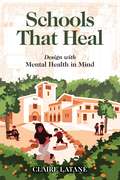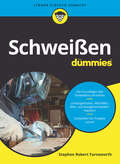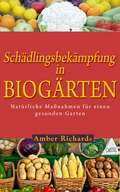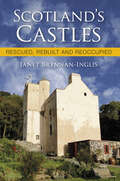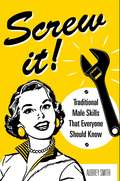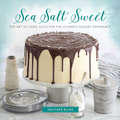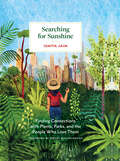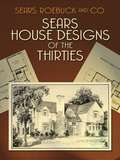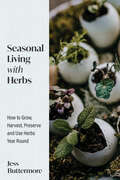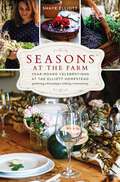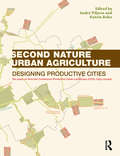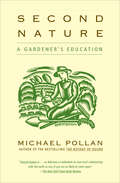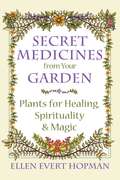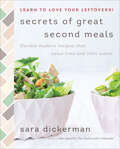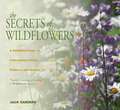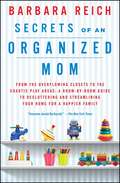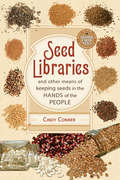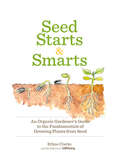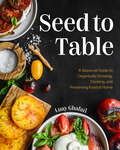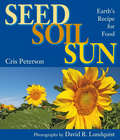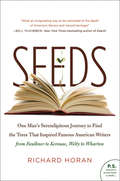- Table View
- List View
Schools That Heal: Design with Mental Health in Mind
by Claire LataneWhat would a school look like if it was designed with mental health in mind? Too many public schools look and feel like prisons, designed out of fear of vandalism and truancy. But we know that nurturing environments are better for learning. Access to nature, big classroom windows, and open campuses consistently reduce stress, anxiety, disorderly conduct, and crime, and improve academic performance. Backed by decades of research, Schools That Heal showcases clear and compelling ways—from furniture to classroom improvements to whole campus renovations—to make supportive learning environments for our children and teenagers. With invaluable advice for school administrators, public health experts, teachers, and parents Schools That Heal is a call to action and a practical resource to create nurturing and inspiring schools for all children.
Schweißen für Dummies (Für Dummies)
by Steven Robert FarnsworthSie wollen Schweißen lernen? Sei es als Hobby, beruflich oder im Rahmen einer Ausbildung? Dann ist dieses Buch das richtige für Sie. Stephen Robert Farnsworth hilft Ihnen bei den ersten Schritten, das Schweißen zu erlernen. Er erklärt Ihnen, was Sie zu Lichtbogenhand-, MIG/MAG-, WIG- und Autogenschweißen wissen sollten. Sie erfahren, was Sie bei welchen Metallen beachten sollten und wann sich welches Schweißverfahren anbietet. Ein besonderes Augenmerk legt der Autor auf die Sicherheit, denn die geht schließlich immer vor. So sind Sie mit diesem Buch rundum gut beraten, wenn Sie Schweißen lernen wollen.
Schädlingsbekämpfung in Biogärten: Natürliche Maßnahmen für einen gesunden Garten
by Amber RichardsSie sind besorgt um giftige Chemikalien in Ihren Garten, besonders auf selbst angebautem Obst und Gemüse? Das sollten Sie auch, denn diese Chemikalien stellen ein Gesundheitsrisiko für Sie und Ihre Familie, Ihre Haustiere und die Umwelt dar. Dennoch gibt es ein Problem. Wie schützen Sie Ihren Garten vor gierigen Schädlingen und Pflanzenkrankheiten? Schädlingsbekämpfung in Biogärten ist ein E-Book für Gärtner (insbesondere für Neulinge) und liefert praktische und überraschende Methoden, die funktionieren. Hierbei werden ausschließlich Methoden beschrieben, die ökologische und natürliche Mittel und Strategien beinhalten. Selbst angebaute, biologische Lebensmittel sind frischer, gesünder und geschmackvoller als chemisch behandelte Produkte. Außerdem schützen Sie durch den Verzicht auf Chemikalien die Umwelt. Mit dem Anbau Ihres eigenen Obsts und Gemüses können Sie Ihre Lebensmittelkosten reduzieren und gleichzeitig einem interessanten Hobby nachgehen. Wenn Sie nicht genug Zeit oder Platz für einen großen Garten haben, empfehle ich Ihnen die Anschaffung von Hochbeeten. In diesem Buch finden Sie hilfreiche Tipps für eine gesunde und leckere Ernte. Laden Sie jetzt Ihr Exemplar herunter.
Scotland's Castles: Rescued, Rebuilt and Reoccupied
by Janet Brennan-InglisScotland’s Castles is a beautifully illustrated celebration and account of the renaissance of Scottish castles that has taken place since 1950. Over 100 ruined and derelict buildings – from tiny towers to rambling baronial mansions – have been restored as homes, hotels and holiday lets. These restorations have mainly been carried out by new owners without any connections to the land or the family history of the buildings, which they bought as ruins. Their struggles and triumphs, including interviews and first-person accounts, form the core of the book, set in the context of the enormous social, political and economic changes of the late twentieth century.
Screw It!: Traditional Male Skills That Everyone Should Know
by SmithHave you ever wondered how you’d survive without a man to attend to the odd jobs around the house? Have you ever wished you knew how to put up a shelf or check the oil in your car? And, more importantly, not have to call a man around to help? Then this is the book for you! From changing a car tire and checking brake fluid and coolant to building a campfire, Screw It! features traditionally male skills to help you learn invaluable information. Divided into sections focusing on vehicle maintenance, the home, the garden, and the great outdoors, each task is concisely explained and accompanied by beautifully illustrated instructions. Never again will you need to rely on men! This essential guide will help you become a completely self-sufficient and independent woman in today’s world.
Sea Salt Sweet: The Art of Using Salts for the Ultimate Dessert Experience
by Heather BairdMake Your Desserts Even Sweeter--With Salt! If you've ever dipped pretzels in melted chocolate or sprinkled salt over a juicy melon slice, then you’ve discovered the magic alchemy in mixing saltiness with sweetness. The recipes in Sea Salt Sweet take it up a notch, combining these two great tastes in ways you’ve never imagined. Award-winning blogger and master baker Heather Baird teaches you how to use fine artisan salts -- from Maldon Sea Salt and Red Hawaiian Salt, to Himalayan Black and French Grey Salt -- to make mouthwatering desserts for any occasion. From sure-to-please classics like Chocolate Chunk Kettle Chip Cookies and Lemon Pie with Soda Cracker Crust, to more exotic choices like Black Sesame Cupcakes with Matcha Buttercream or Smoke & Stout Chocolate Torte, Sea Salt Sweet offers delectable "must-try” treats for the salty-sweet lover.
Searching for Sunshine: Finding Connections with Plants, Parks, and the People Who Love Them
by Ishita JainWhen Ishita Jain relocated to the visually overwhelming and concrete-filled New York City from New Delhi, India, she found solace in parks and gardens and started thinking about how important these places are to city residents' sense of peace. In Searching for Sunshine, Jain follows her curiosity and creativity to provide a vibrant compilation of essays, illustrations, and interviews centered around the simple yet compelling theme of why and how plants and green spaces create such meaning for us.Whether living in a setting that is urban, rural, or somewhere in between, everyone can find enjoyment in the beautiful illustrations and stories gathered here. Featuring conversations with experts and plant-lovers alike, including scientists at the New York Botanical Gardens, groundskeepers at the famed Green-Wood Cemetery, shoppers at the beloved Union Square Greenmarket, a director of NYC Parklands, a florist, and more, Jain's exploration of plants and parks in New York City demonstrates how nature is vital to all experiences of our lives.
Sears House Designs of the Thirties (Dover Architecture Ser.)
by Co. Roebuck SearsProudly promoting itself as "the largest home building organization in the world," Sears, Roebuck and Company advertised in 1932 products in a handsome catalog that also displayed a full-size replica of Mount Vernon, created from Sears materials for a Paris exposition in 1932.At the heart of this now-rare publication were measured floor plans for 68 Sears homes. Over 200 illustration displayed interiors and exteriors for such handsome residences as the Belmont, a six-room house with vestibule, breakfast alcove, three bedrooms, and one-and-a-half baths; and the Dover, an English-styled cottage with a massive chimney and unusual roof lines. Photographs of some interiors revealed a furnished living room with paneled side walls and hewed oak ceiling beams; a spacious kitchen with contemporary appliances; a 60-foot living room with a huge stone fireplace, built-in bookshelves, a vaulted ceiling, and other designs.An invaluable sourcebook for restorationists, this handsome volume will also be of use to people interested in preserving homes of the period. It will be welcomed by anyone who relishes a glimpse of America's architectural past.
Sears Modern Homes, 1913 (Dover Architecture Ser.)
by Co. Roebuck SearsFor thousands of Americans, catalogs such as Sears' Modern Homes were the first step in realizing their dreams of owning a home. Reproduced from a rare 1913 edition, this volume features 112 designs for homes of "comfort and refinement." These authentic plans offer a wealth of information on building materials and other details, along with external views, floor plans, descriptions with prices, and more. Antique collectors, home hobbyists, and fans of traditional design will find this book a bountiful resource for valuable tips on building and restoration.
Seasonal Flower Arranging: Fill Your Home with Blooms, Branches, and Foraged Materials All Year Round
by Julie Michaels Ariella ChezarThis lavishly photographed book from renowned floral designer Ariella Chezar provides step-by-step instructions for 39 seasonal floral arrangements and projects that celebrate the splendor of flowers, the bounty of the changing seasons, and the wild beauty of nature in your home.Just as fruits and vegetables taste best when they are harvested locally and seasonally, flowers that are picked close to home and at their peak reflect a true connection to time and place. Nature does not deliver its harvest all at once--each season has its stars and Ariella Chezar, author of The Flower Workshop, shows you how to make the most of them. Seasonal Flower Arranging follows Mother Nature's lead to create dazzling arrangements from the distinctive gifts of the changing seasons, from a charming spring bouquet for Mother's Day to a bold garland for a summer wedding, and from a bounteous Thanksgiving table to a wintery holiday wreath. There are arrangements for seasonal holidays, special occasions, or just everyday life featuring tulips, roses, peonies, dahlias, and other flowers that are easily found at farmers' markets, local shops, or grown in your own backyard. The book includes detailed instructions on how to re-create 39 floral designs, plus the inspiration and techniques to allow you to create your own original art out of nature.
Seasonal Living with Herbs: How to Grow, Harvest, Preserve and Use Herbs Year Round
by Jess ButtermoreEnhance Your Home and Health with Seasonal HerbsThe ultimate guide to seasonal herbs, Seasonal Living with Herbs is a transformative book that explores the medicinal, culinary, and crafting uses of herbs.Unlock the full potential of seasonal herbs. This is your go-to resource for discovering the extraordinary benefits of nature's bounty. Learn how to preserve herbs and harness their medicinal properties, explore creative ways to use herbs in your everyday life, and cultivate a deeper connection to the natural world.Discover the secrets of herbal abundance with Seasonal Living with Herbs—a comprehensive book that invites you to embrace the beauty and benefits of seasonal herbs. With guidance for growing and caring for herbs in every season, you'll learn to harness their full potential. Delight in the herbal spotlights specific to each season, savor the flavors of seasonal recipes, and create stunning crafts that celebrate the natural world. From cultivating your own herb garden to preserving their essence, this book empowers you to infuse your daily life with the magic of herbs.Inside, you'll find:Herbal spotlights highlighting the unique properties of seasonal herbsRecipes using herbs that showcase their flavors and aromasFrom your garden to your craft projects inspired by the beauty of herbsStep-by-step instructions on how to preserve herbs and their benefitsIf you enjoyed books on how to use herbs like The Herbal Medicine-Maker's Handbook, The Herbal Kitchen, or The Healing Kitchen, you'll love Seasonal Living with Herbs.
Seasons at the Farm: Year-Round Celebrations at the Elliott Homestead
by Shaye ElliottFollowing the success of Welcome to the Farm, Shaye Elliott shares how she celebrates family and farm traditions year-round in Seasons at the Farm. With her engaging storytelling and gorgeous full-color photos,Shaye brings to life how to entertain simply yet beautifully without mortgaging the farm. Simple recipes, decorating advice, and projects make this an inspirational and aspirational sequel to her beloved previous books.
Second Chances: The Ultimate Guide to Thrifting, Sustainable Style, and Expressing Your Most Authentic Self
by Macy EleniBecome a thrifting queen and discover the exciting world of secondhand shopping with this comprehensive guide from TikTok style star Macy Eleni. Macy Eleni is a thrifting expert. Bargain hunting since she was a teen who was short on cash and long on a desire to express herself, she knows that staying on trend without breaking the bank—or increasing your carbon footprint—is not only easy, but also thrilling. Second Chances is a unique guide to a one-of-a-kind, circular wardrobe. Eleni&’s superpower is sniffing out great finds and here she walks you through the art of in-person discovery at thrift stores and vintage shops, estate sales and flea markets, yard sales and antique stores—and online resale platforms. This book will teach you how to organize your existing wardrobe, evaluate pieces you find, and manifest your dream closet. After more than a decade as a thrifting expert, Macy has compiled every tip and trick in the second-hand shopping world from sizing and repairing to tailoring and cleaning—this book covers it all. Macy also calls on other thrifting experts of diverse backgrounds to share advice about how to navigate a fashion landscape with regard to body type, gender, and ethnicity, so you can easily seek out the clothes that speak to your unique identity. Whether you&’re a seasoned thrifter or just getting started, this book will be your go-to guide for looking your best, feeling your best, and giving clothes the second and third lives they deserve!
Second Nature Urban Agriculture: Designing Productive Cities
by André Viljoen Katrin BohnWinner of the 2015 RIBA President's Award for Outstanding University Located Research This book is the long awaited sequel to "Continuous Productive Urban Landscapes: Designing Urban Agriculture for Sustainable Cities". "Second Nature Urban Agriculture" updates and extends the authors' concept for introducing productive urban landscapes, including urban agriculture, into cities as essential elements of sustainable urban infrastructure. It reviews recent research and projects on the subject and presents concrete actions aimed at making urban agriculture happen. As pioneering thinkers in this area, the authors bring a unique overview to contemporary developments and have the experience to judge opportunities and challenges facing those who wish to create more equitable, resilient, desirable and beautiful cities.
Second Nature: A Gardener's Education (Bloomsbury Paperbacks Gardening Classics Ser.)
by Michael PollanChosen by the American Horticultural Society as one of the seventy-five greatest books ever written about gardening, Second Nature has become a manifesto for rethinking our relationship with nature. With chapter ranging from a reconsideration of the Great American Lawn and a dispatch from one man’s war with a woodchuck to reflections on the sexual politics of roses, Pollan captures the rhythms of our everyday engagement with the outdoors in all its glory and exasperation.
Secret Medicines from Your Garden: Plants for Healing, Spirituality, and Magic
by Ellen Evert HopmanA guided exploration of herbal lore and healing plants found in yards, forests, meadows, and hedgerows• Draws on traditional knowledge and remedies from around the world, including Native American, Celtic, and Egyptian traditions• Provides simple recipes to safely make herbal remedies from local plants and honey for first aid, immune support, and treatment of common ailments• Details the “triangle” formula-making system of William LeSassier• Explains how to work with plant spirits, herbal astrology, and Animal Spirit MedicineWeaving together ancient wisdom, mystical folklore, and modern plant research, master herbalist Ellen Evert Hopman explores the many uses of flowers, trees, common weeds, and ornamental plants for food, medicine, spiritual growth, and magical rituals. She reveals the herbal lore surrounding each plant, drawing on traditional knowledge and remedies from around the world, including Native American, Celtic, and Egyptian traditions. She includes recipes throughout so you can make medicines from wild and domesticated plants easily found in yards, forests, meadows, and hedgerows, and she discusses what to plant to ensure you have leaves, berries, and flowers all year.The author reveals how to quickly intuit an unknown plant’s properties using the signatures of plants--universal indications and contraindications based on the form, color, and location of a plant. She includes an in-depth section on honey and Bee Medicine, allowing you to appreciate the labors of these plant-dependent insects. Exploring the magical role of herbs in ancient ritual, Hopman provides recipes for Egyptian temple incense and their sacred medicine known as “Kyphi” or “Kaphet,” used to purify the body, banish insomnia, and promote vivid dreaming. She explores shamanic Plant Spirit and Animal Spirit Medicine as well as herbal astrology. She also explains the “triangle” formula-making system of her herbal mentor William LeSassier to help you develop custom herbal remedies tailored to a person’s unique strengths and weaknesses.Showing how to easily incorporate wild plants into your life to receive their healing benefits throughout the seasons, Hopman reveals the power of the bounty that Mother Nature has provided right at our doorstep.
Secrets of Great Second Meals: Flexible Modern Recipes That Value Time and Limit Waste
by Sara DickermanA James Beard award winner offers ‘‘an invitation to ‘start riffing with the contents of your refrigerator’ and encourage a new perspective on leftovers’’ (Publishers Weekly).When it comes to leftovers, Sara Dickerman believes that there is nothing better than figuring out the right way to reframe a good meal into another, potentially great meal. Second meals aren’t just reheating last night’s dinner. At Sara’s house, re-invention might mean pureeing roasted vegetables into a quick soup, crafting a beautiful salad with some second-day salmon, or stuffing cooked rice into roasted poblano peppers. But unlike other cookbooks that emphasize thrift, Secrets of Great Second Meals focuses on creating inviting, sophisticated, and healthy recipes that are flexible enough to adapt to what you have on hand.Sara shows how to make the most of your food the way chefs do. With a little planning, you can look at extra food from one dinner as components to another meal that has already been prepped. Sara provides a list of the top ten most versatile dishes for multiple meals, offers advice on food storage, and includes tips on adding freshness and flavor using salt, acids, herbs, and texture. Most importantly, she gives home cooks the tools they need to improvise confidently.Illustrated with full-color photos, Secrets of Great Second Meals makes re-imagining food for a second meal not just a good, cheap, waste-reducing thing to do, but way of making every day eating more inventive and enticing.“[For] anyone who has ever looked quizzically at a container of leftovers while trying to plan a new meal will find what they’re looking for.” —Booklist
Secrets of Wildflowers: A Delightful Feast Of Little-Known Facts, Folklore, And History
by Jack SandersNow available in paperback, The Secrets of Wildflowers is destined to be an indispensable book for anyone who loves and admires the natural world. Few things in nature beautify the world more than wildflowers. Their countless colors and endless designs are found almost anywhere—from fields to woods, deserts to ponds, and even in junkyards, dumps, and cracks in the pavement.The Secrets of Wildflowers, Jack Sanders’s colorful tribute, is bursting with odd facts and wonderful superstitions about some of North America’s most beautiful and common plants. Reader's will find natural history, folklore, habitats, horticulture, ingenious uses past and present, origins of names, and even their literary pedigrees. Far richer and eminently more varied than any field guide, The Secrets of Wildflowers contains more than 100 species of North American wildflowers organized by blooming seasons. Wildflowers are not just pretty to look at; they are an essential part of our environment. How they grow and what they do are often overlooked, and how they have been used has largely been forgotten. They feed insects, birds, animals, and even humans. They hold and condition the soil, and they are used in modern medicines and natural remedies and appear throughout history in art and literature. The Secrets of Wildflowersprovides detailed information on more than one hundred representative species of North American wildflowers.
Secrets of an Organized Mom: From the Overflowing Closets to the Chaotic Play Areas: A Room-by-Room Guide to Decluttering and Streamlining Your Home for a Happier Family
by Barbara ReichMom&’s Choice Awards Gold Award Recipient Professional organizer Barbara Reich offers a life-changing program—focused on decluttering and streamlining your home—that helps families live simpler, less chaotic lives: &“Everyone should Barbarafy,&” raves The New York Times.Mothers can feel like life is one never-ending loop. Just when one problem or responsibility is overcome, another one trips us up. But help is on the way: Barbara Reich has all the strategies for staying ahead of the curve—and she’s wrapped them up into four easy steps that can be applied to any organizing project: purge, design, organize, and maintain. The keys to Barbara’s success are simplicity and consistency. Room by room, she goes through the most problematic areas in the home—from the tornado-struck play area to the packed basement or storage unit—and approaches organizing in manageable bites. In addition to cleaning and organizing tips, she talks about how to avoid social overload, preaching the power of “No”—for example, when your child wants to attend six birthday parties in one weekend. As the mother of thirteen-year-old twins, Barbara offers insight into the lives of crazed moms as only a mother could. Combining the humor of a sympathetic friend and the no-nonsense advice of a true type-A personality, Reich offers clever, appealing solutions that are genuinely achievable for everyone.
Secrets of the Garden: Food Chains and the Food Web in Our Background
by Kathleen Weidner ZoehfeldPerfect for Earth Day and spring planting season--an outstanding book about backyard science the whole family will appreciate. Alice's family plants a vegetable garden each spring, and this budding naturalist reports all she sees about how the plants grow, what insects come to eat the plants, and what birds and animals come to eat the insects. It's the food chain, right in her own backyard! While Alice's narrative is simple and engaging, science concepts are presented in more depth in sidebars by a pair of very knowledgeable (and highly amusing) chickens! Noted science writer Kathleen Weidner Zoehfeld knows how to layer information to make it accessible to a wide range of readers and useful for educators. And illustrator Priscilla Lamont's funny, friendly paintings make this a garden everyone will want to explore. Kids will eat up this wonderful book of backyard science—and perhaps they'll even be inspired to eat their vegetables!
Seed Libraries: And Other Means of Keeping Seeds in the Hands of the People
by Cindy ConnerHistorically, seed companies were generally small, often family-run businesses. Because they were regionally based, they could focus on varieties well-suited to the local environment. <P><P>A Pacific Northwest company, for example, would specialize in different cultivars than a company based in the Southeast. However the absorption of these small, independent seed businesses into large multinationals, combined with the advancement of biotechnology resulting in hybrids and GMO seeds, has led to a serious loss of genetic diversity. The public is now at the mercy of the corporations that control the seeds.In the past few years, gardeners have realized the inherent danger in this situation. A growing movement is striving to preserve and expand our stock of heritage and heirloom varieties through seed saving and sharing opportunities. Seed Libraries is a practical guide to saving seeds through community programs, including: Step-by-step instructions for setting up a seed library A wealth of ideas to help attract patrons and keep the momentum going Profiles of existing libraries and other types of seed saving partnershipsWhoever controls the seeds controls the food supply. By empowering communities to preserve and protect the genetic diversity of their harvest, Seed Libraries is the first step towards reclaiming our self-reliance while enhancing food security and ensuring that the future of food is healthy, vibrant, tasty, and nutritious.Cindy Conner is a permaculture educator, founder of Homeplace Earth and producer of two popular instructional gardening DVDs. She is also the author of Grow a Sustainable Diet.
Seed Starts & Smarts: An Organic Gardener's Guide to the Fundamentals of Growing Plants from Seed
by Organic Gardening Ethne ClarkeWhether broadcast across a prepared seedbed or tucked into a container of growing medium, seeds hold the promise of something much bigger--juicy tomatoes, lush foliage, and brilliant blossoms. And growing plants from seed is easy and inexpensive (as well as rewarding) for the gardener ready to try new or regional varieties. Seed Starts & Smarts features sowing and growing advice for more than 70 edible garden crops--including vegetables, herbs, and fruits--along with tips and techniques for growing the most popular ornamentals from seed, region-specific information, and general timing guidelines.
Seed to Table: A Seasonal Guide to Organically Growing, Cooking, and Preserving Food at Home
by Luay GhafariA Seasonal Guide for Growing & Cooking Foods Right at Home“Luay makes growing your own food, even if just a small amount, into an achievable endeavor.”—Niki Irving of Flourish Flower Farm, flower farmer, florist, author of Growing Flowers#1 Best Seller in Organic GardeningLearn to garden in any space with Seed to Table, grow and cook nutrient-dense foods to take your gardening and cooking to the next level!Gardening, cooking, and eating done right!Seed to Table focuses on how to feed your family with nutritious foods from your own outdoor, home and/or kitchen garden. Whether you live in a city or in the country, this book gives you tools on effective growing techniques, seed starting methods, and garden maintenance. Organic gardening for every individual style! Have fun while you create your own gardening system whether it be for a container garden or a kitchen garden. Try out big and small garden ideas to stock up your fridge with delicious fruits, vegetables, and herbs to grow your self-sufficiency. Maximize your minimal or large space with impactful practices that are perfect for anyone on a sustainability and self-sufficiency journey.Inside Seed to Table, you’ll find:A full and in-depth guide on preserving foods while cultivating homegrown foodsEasy and delicious vegetable-forward recipes and preservation techniques to feed your whole familyEffective urban gardening tools to create a garden in a patio garden, rooftop space, or any spaceIf you're looking for books on urban gardening or gardening in any space, add this book to your collection! If you liked Plants-Only Kitchen, Holistic Homesteading, or Raised-Bed Gardening for Beginners, then you’ll love Seed to Table.
Seed, Soil, Sun: Earth's Recipe for Food
by Cris Peterson David R. LundquistSeed, Soil, Sun. With these simple ingredients, nature creates our food. Once again, noted author Cris Peterson brings both wonder and clarity to the subject of agriculture, celebrating the cycle of growth, harvest, and renewal. Using the corn plant as an example, she takes the reader through the story of germination and growth of a tiny corn seed into a giant plant reaching high into the air, with roots extending over six feet into the ground. This American Farm Bureau Foundation's Agriculture Book of the Year also discusses the make-up of soil and the amazing creatures who live there--from microscopic one-celled bacteria to moles, amoebas, and earthworms. David Lundquist's stunning photographs bring an immediacy and vibrancy to the seemingly miraculous process.
Seeds
by Richard HoranFrom the wooded road made of golden hemlock running past L. Frank Baum's childhood home to the lonely stump of Scout's oak in Harper Lee's Alabama, author Richard Horan gathers tree seeds-and stories-from the homes of America's most treasured authors. At once a heartfelt paean to literature and a wise, funny, and uplifting account of one man's reconnection with nature, Seeds celebrates Horan's triumphs and calamities on his quest to link trees with great writers-a delightfully original meditation on the nature of inspiration and a one-of-a-kind adventure into literature.
